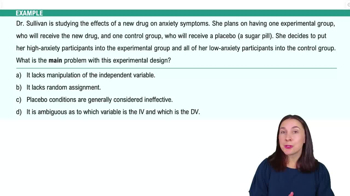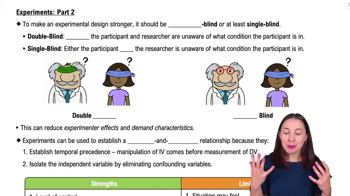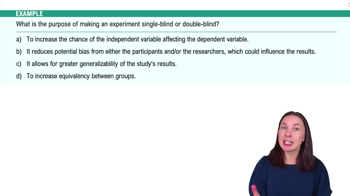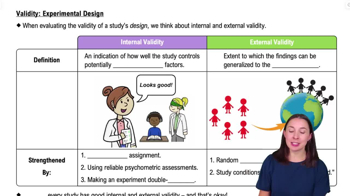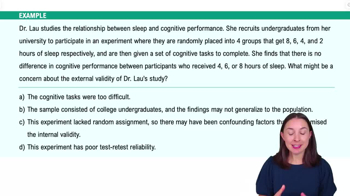Table of contents
- 1. Introduction to Psychology1h 43m
- 2. Psychology Research2h 20m
- 3. Biological Psychology2h 41m
- 4. Sensation and Perception28m
- 5. Consciousness and Sleep32m
- 6. Learning41m
- 7. Memory34m
- 8. Cognition37m
- 9. Emotion and Motivation35m
- 10. Developmental Psychology33m
- 11. Personality48m
- 12. Social Psychology41m
- 13. Stress and Health41m
- 14. Psychological Disorders44m
- 15. Treatment47m
2. Psychology Research
Intro to Research Methods
Struggling with Psychology?
Join thousands of students who trust us to help them ace their exams!Watch the first videoMultiple Choice
In order to control emotions, the technique of distraction has been linked to what area of the brain?
A
Lateral prefrontal cortex
B
Anterior cingulate cortex
C
Lateral orbitofrontal cortex
D
Right frontal lobe
 Verified step by step guidance
Verified step by step guidance1
Understand the role of the anterior cingulate cortex (ACC) in emotion regulation. The ACC is involved in a variety of functions, including emotion regulation, decision-making, and impulse control.
Recognize that the technique of distraction is a cognitive strategy used to divert attention away from emotional stimuli, thereby reducing emotional impact.
Identify the connection between the ACC and distraction. The ACC is known to be active during tasks that require cognitive control and attention, which are essential components of distraction.
Consider the involvement of other brain areas listed, such as the lateral prefrontal cortex and lateral orbitofrontal cortex, which are also involved in cognitive processes but may not be as directly linked to the specific technique of distraction in emotion regulation.
Conclude that the anterior cingulate cortex is the area most closely associated with the use of distraction as a technique for controlling emotions, based on its role in attention and cognitive control.

 1:46m
1:46mWatch next
Master Roadmap of the Lesson with a bite sized video explanation from Hannah Gordils
Start learningRelated Videos
Related Practice










